1997 SSANGYONG KORANDO airbag disable
[x] Cancel search: airbag disablePage 1589 of 2053
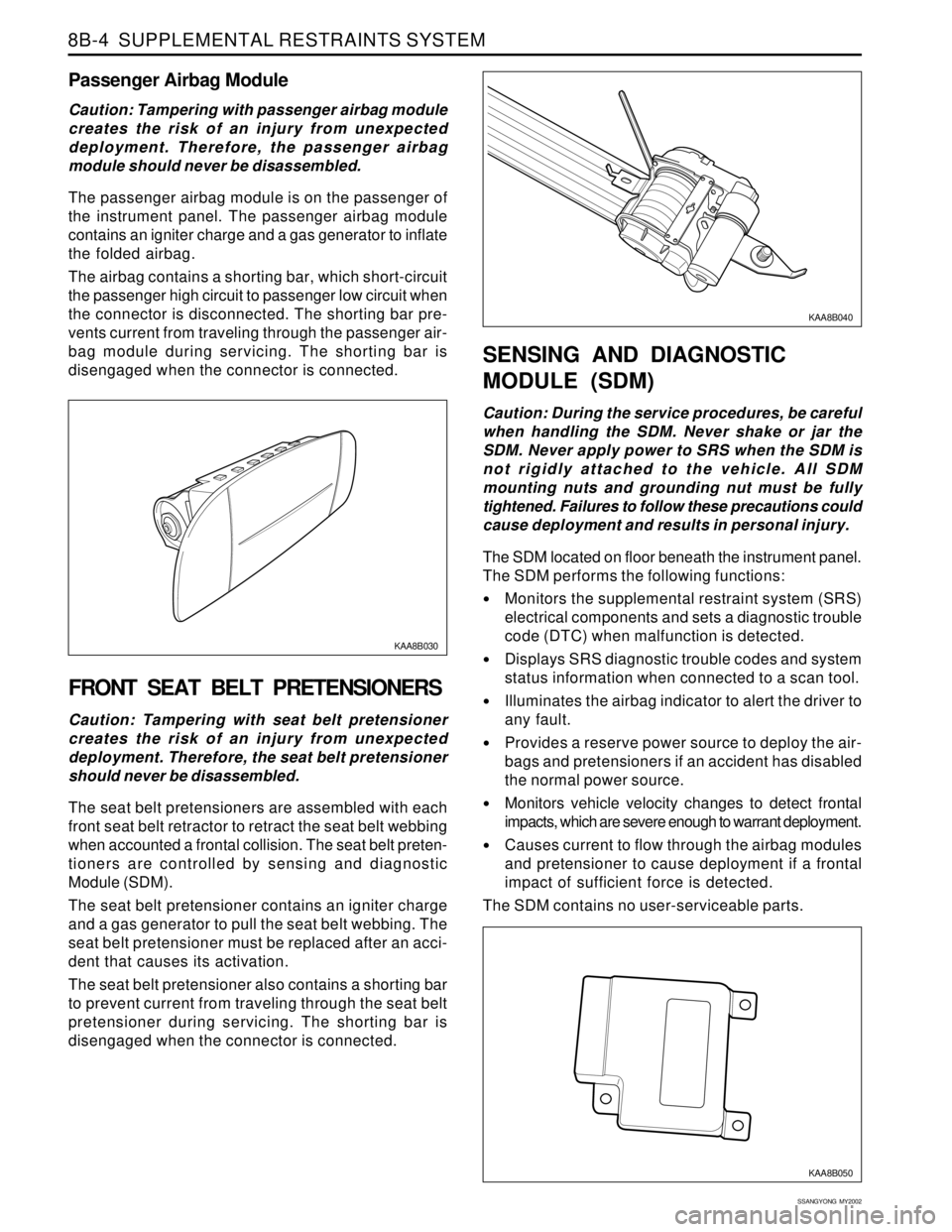
SSANGYONG MY2002
8B-4 SUPPLEMENTAL RESTRAINTS SYSTEM
KAA8B030
KAA8B040
Passenger Airbag Module
Caution: Tampering with passenger airbag module
creates the risk of an injury from unexpected
deployment. Therefore, the passenger airbag
module should never be disassembled.
The passenger airbag module is on the passenger of
the instrument panel. The passenger airbag module
contains an igniter charge and a gas generator to inflate
the folded airbag.
The airbag contains a shorting bar, which short-circuit
the passenger high circuit to passenger low circuit when
the connector is disconnected. The shorting bar pre-
vents current from traveling through the passenger air-
bag module during servicing. The shorting bar is
disengaged when the connector is connected.
FRONT SEAT BELT PRETENSIONERS
Caution: Tampering with seat belt pretensioner
creates the risk of an injury from unexpected
deployment. Therefore, the seat belt pretensioner
should never be disassembled.
The seat belt pretensioners are assembled with each
front seat belt retractor to retract the seat belt webbing
when accounted a frontal collision. The seat belt preten-
tioners are controlled by sensing and diagnostic
Module (SDM).
The seat belt pretensioner contains an igniter charge
and a gas generator to pull the seat belt webbing. The
seat belt pretensioner must be replaced after an acci-
dent that causes its activation.
The seat belt pretensioner also contains a shorting bar
to prevent current from traveling through the seat belt
pretensioner during servicing. The shorting bar is
disengaged when the connector is connected.
SENSING AND DIAGNOSTIC
MODULE (SDM)
Caution: During the service procedures, be careful
when handling the SDM. Never shake or jar the
SDM. Never apply power to SRS when the SDM is
not rigidly attached to the vehicle. All SDM
mounting nuts and grounding nut must be fully
tightened. Failures to follow these precautions could
cause deployment and results in personal injury.
The SDM located on floor beneath the instrument panel.
The SDM performs the following functions:
Monitors the supplemental restraint system (SRS)
electrical components and sets a diagnostic trouble
code (DTC) when malfunction is detected.
Displays SRS diagnostic trouble codes and system
status information when connected to a scan tool.
Illuminates the airbag indicator to alert the driver to
any fault.
Provides a reserve power source to deploy the air-
bags and pretensioners if an accident has disabled
the normal power source.
Monitors vehicle velocity changes to detect frontal
impacts, which are severe enough to warrant deployment.
Causes current to flow through the airbag modules
and pretensioner to cause deployment if a frontal
impact of sufficient force is detected.
The SDM contains no user-serviceable parts.
KAA8B050
Page 1590 of 2053
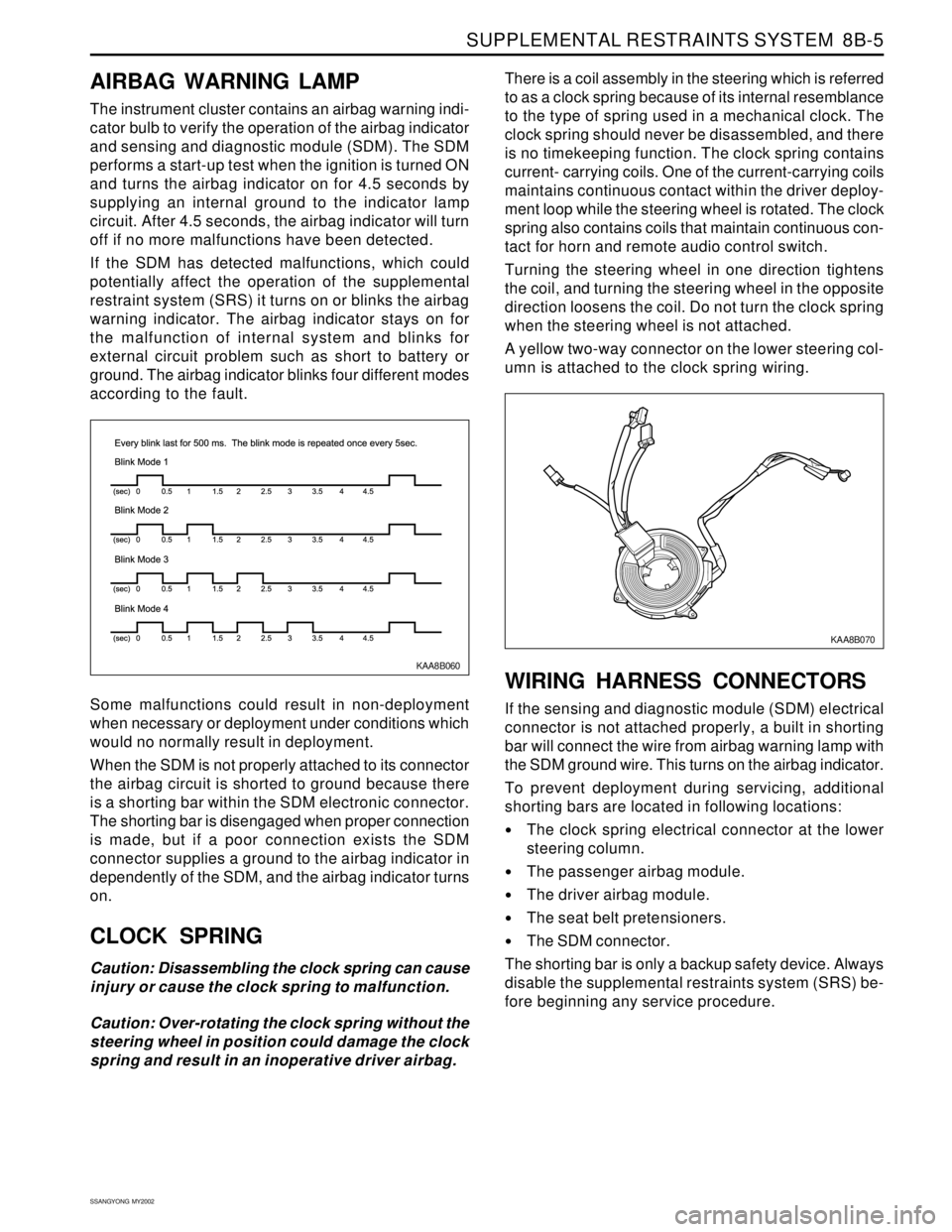
SUPPLEMENTAL RESTRAINTS SYSTEM 8B-5
SSANGYONG MY2002
KAA8B060
AIRBAG WARNING LAMP
The instrument cluster contains an airbag warning indi-
cator bulb to verify the operation of the airbag indicator
and sensing and diagnostic module (SDM). The SDM
performs a start-up test when the ignition is turned ON
and turns the airbag indicator on for 4.5 seconds by
supplying an internal ground to the indicator lamp
circuit. After 4.5 seconds, the airbag indicator will turn
off if no more malfunctions have been detected.
If the SDM has detected malfunctions, which could
potentially affect the operation of the supplemental
restraint system (SRS) it turns on or blinks the airbag
warning indicator. The airbag indicator stays on for
the malfunction of internal system and blinks for
external circuit problem such as short to battery or
ground. The airbag indicator blinks four different modes
according to the fault.
Some malfunctions could result in non-deployment
when necessary or deployment under conditions which
would no normally result in deployment.
When the SDM is not properly attached to its connector
the airbag circuit is shorted to ground because there
is a shorting bar within the SDM electronic connector.
The shorting bar is disengaged when proper connection
is made, but if a poor connection exists the SDM
connector supplies a ground to the airbag indicator in
dependently of the SDM, and the airbag indicator turns
on.
CLOCK SPRING
Caution: Disassembling the clock spring can cause
injury or cause the clock spring to malfunction.
Caution: Over-rotating the clock spring without the
steering wheel in position could damage the clock
spring and result in an inoperative driver airbag.There is a coil assembly in the steering which is referred
to as a clock spring because of its internal resemblance
to the type of spring used in a mechanical clock. The
clock spring should never be disassembled, and there
is no timekeeping function. The clock spring contains
current- carrying coils. One of the current-carrying coils
maintains continuous contact within the driver deploy-
ment loop while the steering wheel is rotated. The clock
spring also contains coils that maintain continuous con-
tact for horn and remote audio control switch.
Turning the steering wheel in one direction tightens
the coil, and turning the steering wheel in the opposite
direction loosens the coil. Do not turn the clock spring
when the steering wheel is not attached.
A yellow two-way connector on the lower steering col-
umn is attached to the clock spring wiring.
WIRING HARNESS CONNECTORS
If the sensing and diagnostic module (SDM) electrical
connector is not attached properly, a built in shorting
bar will connect the wire from airbag warning lamp with
the SDM ground wire. This turns on the airbag indicator.
To prevent deployment during servicing, additional
shorting bars are located in following locations:
The clock spring electrical connector at the lower
steering column.
The passenger airbag module.
The driver airbag module.
The seat belt pretensioners.
The SDM connector.
The shorting bar is only a backup safety device. Always
disable the supplemental restraints system (SRS) be-
fore beginning any service procedure.
KAA8B070
Page 1595 of 2053
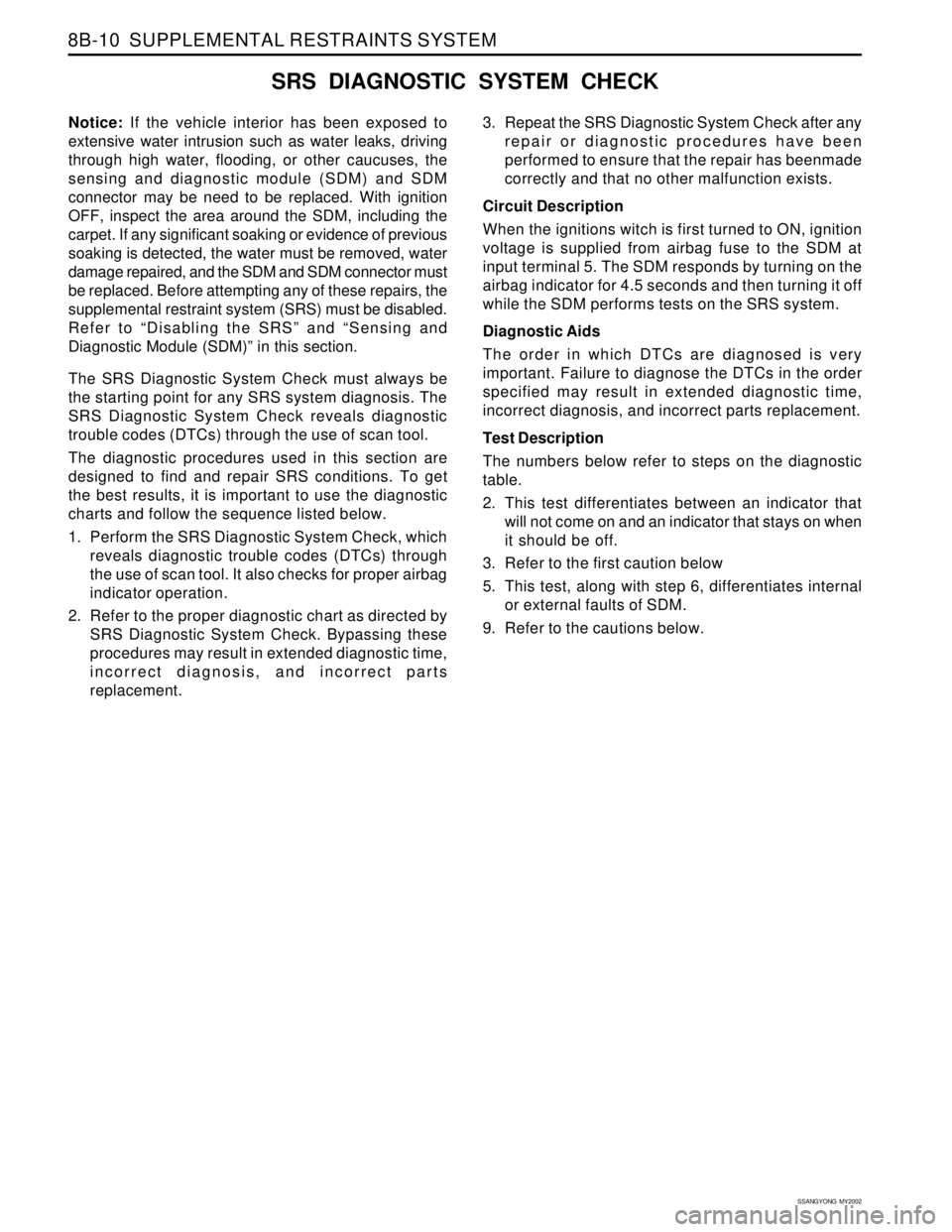
SSANGYONG MY2002
8B-10 SUPPLEMENTAL RESTRAINTS SYSTEM
SRS DIAGNOSTIC SYSTEM CHECK
Notice: If the vehicle interior has been exposed to
extensive water intrusion such as water leaks, driving
through high water, flooding, or other caucuses, the
sensing and diagnostic module (SDM) and SDM
connector may be need to be replaced. With ignition
OFF, inspect the area around the SDM, including the
carpet. If any significant soaking or evidence of previous
soaking is detected, the water must be removed, water
damage repaired, and the SDM and SDM connector must
be replaced. Before attempting any of these repairs, the
supplemental restraint system (SRS) must be disabled.
Refer to “Disabling the SRS” and “Sensing and
Diagnostic Module (SDM)” in this section.
The SRS Diagnostic System Check must always be
the starting point for any SRS system diagnosis. The
SRS Diagnostic System Check reveals diagnostic
trouble codes (DTCs) through the use of scan tool.
The diagnostic procedures used in this section are
designed to find and repair SRS conditions. To get
the best results, it is important to use the diagnostic
charts and follow the sequence listed below.
1. Perform the SRS Diagnostic System Check, which
reveals diagnostic trouble codes (DTCs) through
the use of scan tool. It also checks for proper airbag
indicator operation.
2. Refer to the proper diagnostic chart as directed by
SRS Diagnostic System Check. Bypassing these
procedures may result in extended diagnostic time,
incorrect diagnosis, and incorrect parts
replacement.3. Repeat the SRS Diagnostic System Check after any
repair or diagnostic procedures have been
performed to ensure that the repair has beenmade
correctly and that no other malfunction exists.
Circuit Description
When the ignitions witch is first turned to ON, ignition
voltage is supplied from airbag fuse to the SDM at
input terminal 5. The SDM responds by turning on the
airbag indicator for 4.5 seconds and then turning it off
while the SDM performs tests on the SRS system.
Diagnostic Aids
The order in which DTCs are diagnosed is very
important. Failure to diagnose the DTCs in the order
specified may result in extended diagnostic time,
incorrect diagnosis, and incorrect parts replacement.
Test Description
The numbers below refer to steps on the diagnostic
table.
2. This test differentiates between an indicator that
will not come on and an indicator that stays on when
it should be off.
3. Refer to the first caution below
5. This test, along with step 6, differentiates internal
or external faults of SDM.
9. Refer to the cautions below.
Page 1601 of 2053
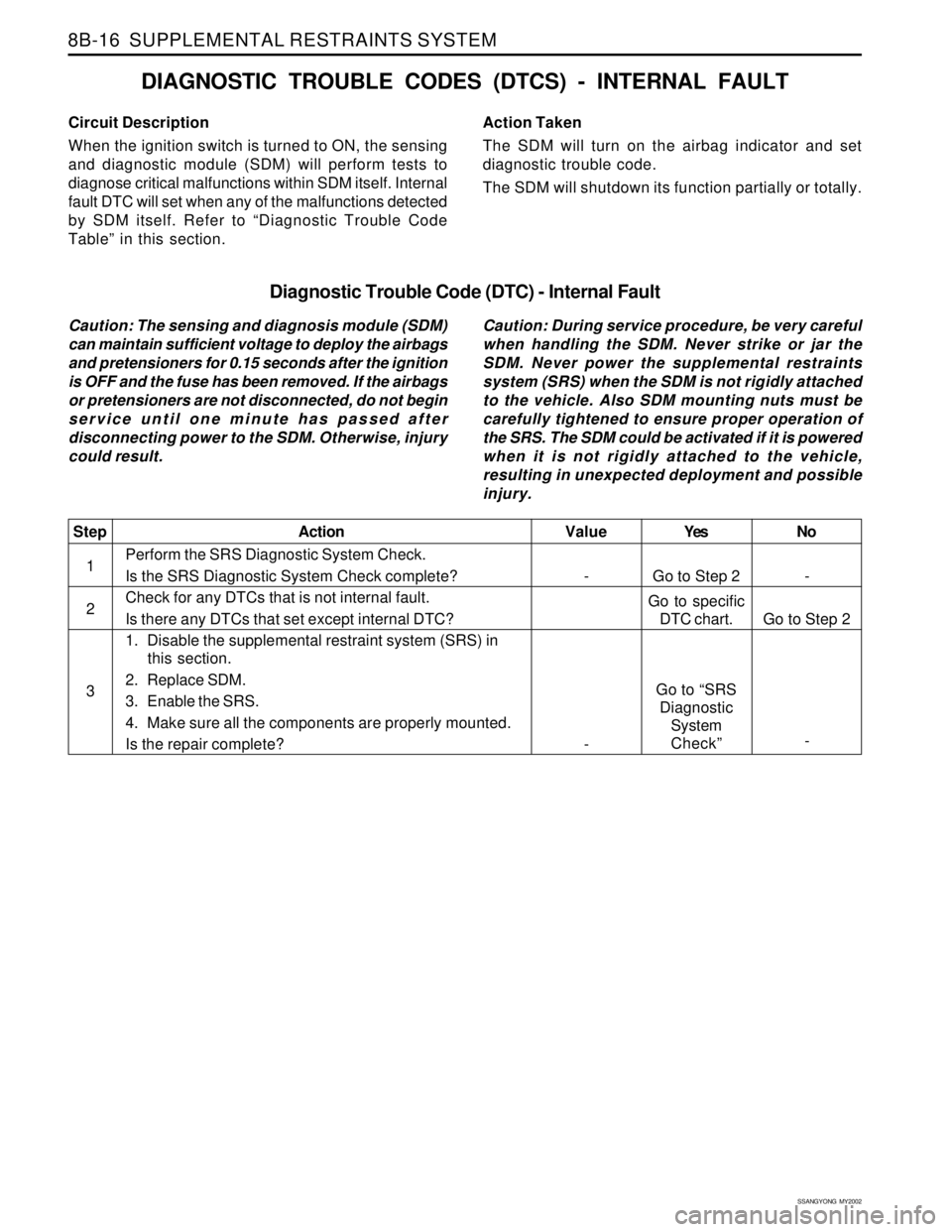
SSANGYONG MY2002
8B-16 SUPPLEMENTAL RESTRAINTS SYSTEM
Yes
Go to Step 2
Go to specific
DTC chart.
Go to “SRS
Diagnostic
System
Check”No
-
Go to Step 2
- Value
-
-Step
1
2
3Action
Perform the SRS Diagnostic System Check.
Is the SRS Diagnostic System Check complete?
Check for any DTCs that is not internal fault.
Is there any DTCs that set except internal DTC?
1. Disable the supplemental restraint system (SRS) in
this section.
2. Replace SDM.
3. Enable the SRS.
4. Make sure all the components are properly mounted.
Is the repair complete?
Circuit Description
When the ignition switch is turned to ON, the sensing
and diagnostic module (SDM) will perform tests to
diagnose critical malfunctions within SDM itself. Internal
fault DTC will set when any of the malfunctions detected
by SDM itself. Refer to “Diagnostic Trouble Code
Table” in this section.
DIAGNOSTIC TROUBLE CODES (DTCS) - INTERNAL FAULT
Action Taken
The SDM will turn on the airbag indicator and set
diagnostic trouble code.
The SDM will shutdown its function partially or totally.
Diagnostic Trouble Code (DTC) - Internal Fault
Caution: The sensing and diagnosis module (SDM)
can maintain sufficient voltage to deploy the airbags
and pretensioners for 0.15 seconds after the ignition
is OFF and the fuse has been removed. If the airbags
or pretensioners are not disconnected, do not begin
service until one minute has passed after
disconnecting power to the SDM. Otherwise, injury
could result.Caution: During service procedure, be very careful
when handling the SDM. Never strike or jar the
SDM. Never power the supplemental restraints
system (SRS) when the SDM is not rigidly attached
to the vehicle. Also SDM mounting nuts must be
carefully tightened to ensure proper operation of
the SRS. The SDM could be activated if it is powered
when it is not rigidly attached to the vehicle,
resulting in unexpected deployment and possible
injury.
Page 1603 of 2053
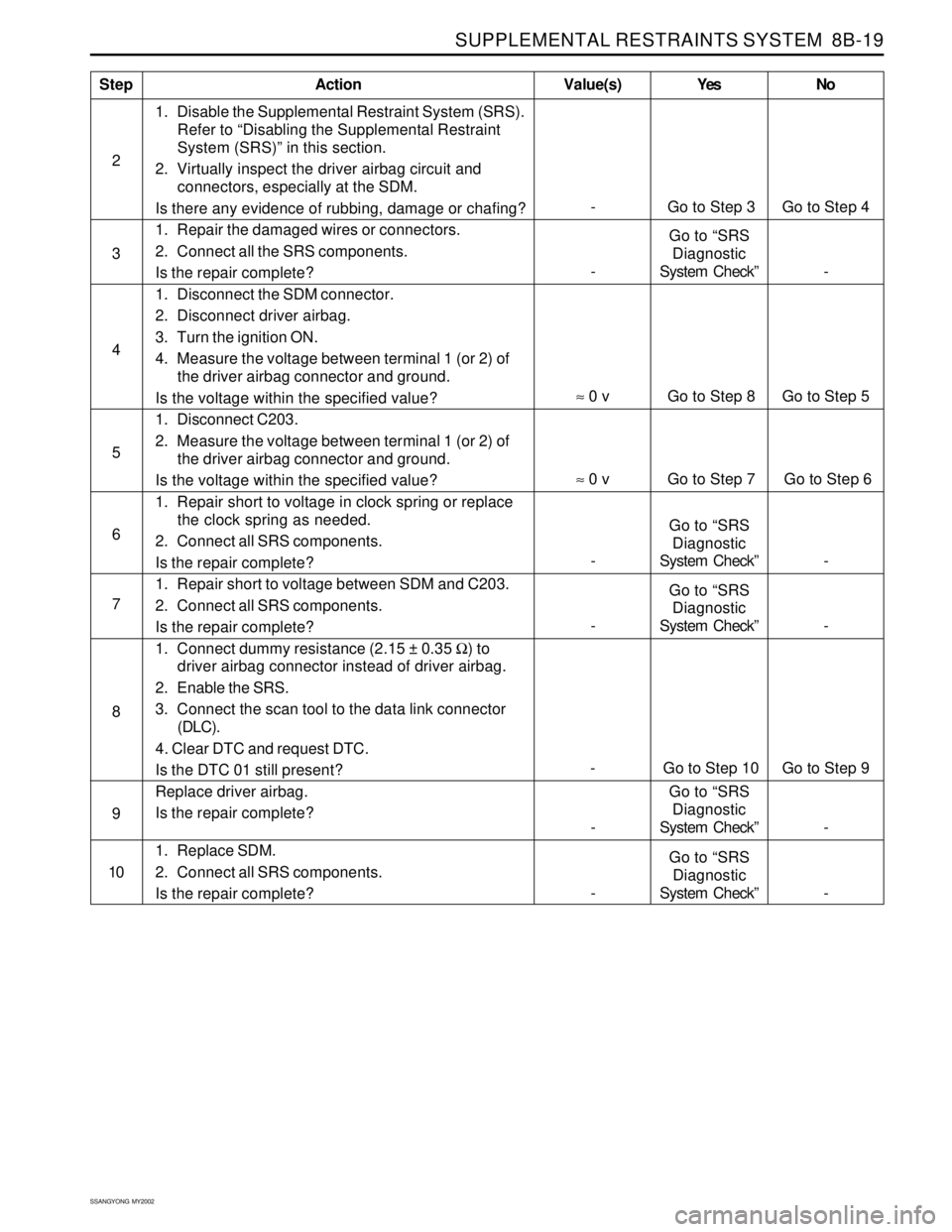
SUPPLEMENTAL RESTRAINTS SYSTEM 8B-19
SSANGYONG MY2002
1. Disable the Supplemental Restraint System (SRS).
Refer to “Disabling the Supplemental Restraint
System (SRS)” in this section.
2. Virtually inspect the driver airbag circuit and
connectors, especially at the SDM.
Is there any evidence of rubbing, damage or chafing?
1. Repair the damaged wires or connectors.
2. Connect all the SRS components.
Is the repair complete?
1. Disconnect the SDM connector.
2. Disconnect driver airbag.
3. Turn the ignition ON.
4. Measure the voltage between terminal 1 (or 2) of
the driver airbag connector and ground.
Is the voltage within the specified value?
1. Disconnect C203.
2. Measure the voltage between terminal 1 (or 2) of
the driver airbag connector and ground.
Is the voltage within the specified value?
1. Repair short to voltage in clock spring or replace
the clock spring as needed.
2. Connect all SRS components.
Is the repair complete?
1. Repair short to voltage between SDM and C203.
2. Connect all SRS components.
Is the repair complete?
1. Connect dummy resistance (2.15 ± 0.35 Ω) to
driver airbag connector instead of driver airbag.
2. Enable the SRS.
3. Connect the scan tool to the data link connector
(DLC).
4. Clear DTC and request DTC.
Is the DTC 01 still present?
Replace driver airbag.
Is the repair complete?
1. Replace SDM.
2. Connect all SRS components.
Is the repair complete?
StepAction Value(s) Yes No
2
4
5
6
- Go to Step 3 Go to Step 4
3
-Go to “SRS
Diagnostic
System Check” -
≈ 0 v Go to Step 8 Go to Step 5
≈ 0 v Go to Step 7 Go to Step 6
-Go to “SRS
Diagnostic
System Check” -
-Go to “SRS
Diagnostic
System Check” -
-Go to “SRS
Diagnostic
System Check” -
-Go to “SRS
Diagnostic
System Check” -
- Go to Step 10 Go to Step 9 7
8
9
10
Page 1605 of 2053
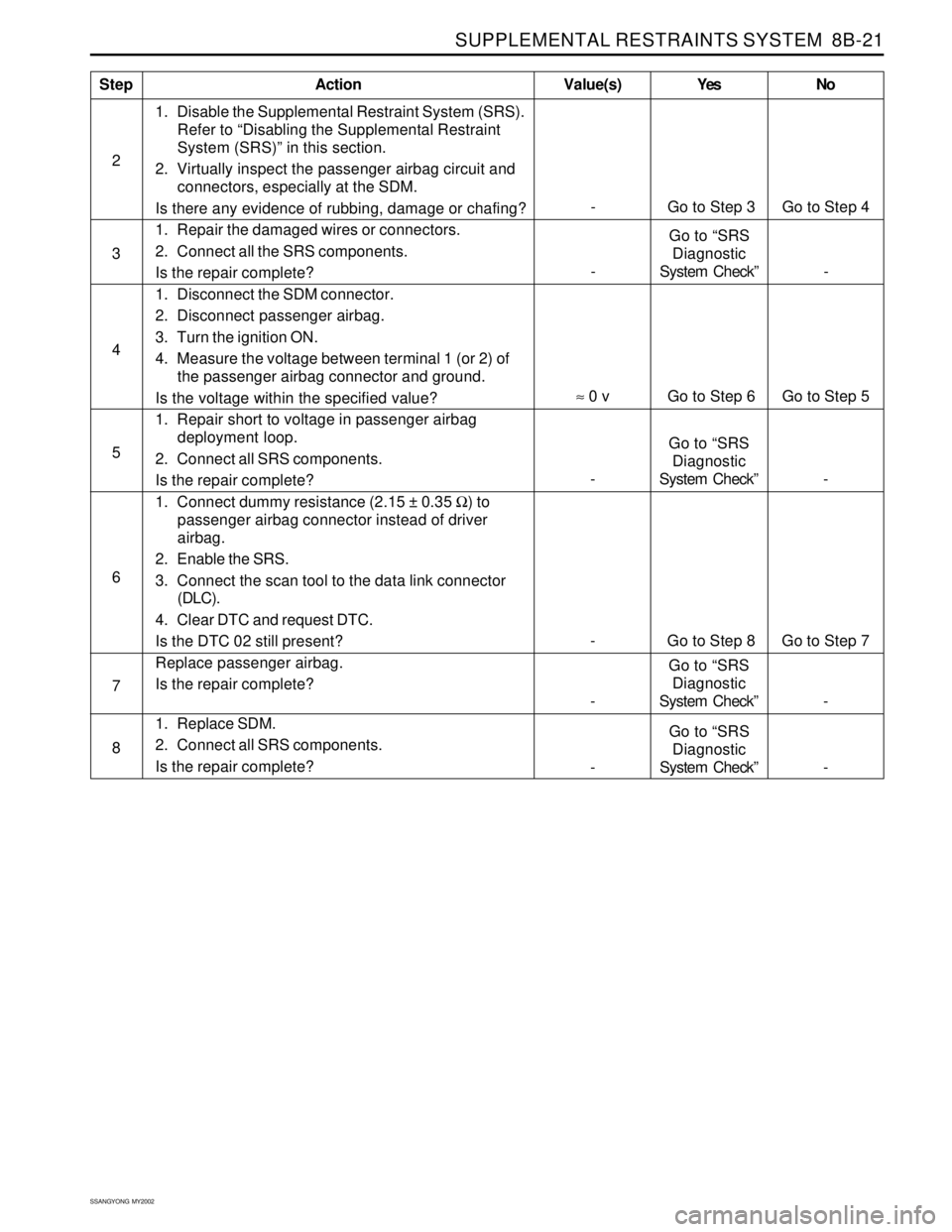
SUPPLEMENTAL RESTRAINTS SYSTEM 8B-21
SSANGYONG MY2002
1. Disable the Supplemental Restraint System (SRS).
Refer to “Disabling the Supplemental Restraint
System (SRS)” in this section.
2. Virtually inspect the passenger airbag circuit and
connectors, especially at the SDM.
Is there any evidence of rubbing, damage or chafing?
1. Repair the damaged wires or connectors.
2. Connect all the SRS components.
Is the repair complete?
1. Disconnect the SDM connector.
2. Disconnect passenger airbag.
3. Turn the ignition ON.
4. Measure the voltage between terminal 1 (or 2) of
the passenger airbag connector and ground.
Is the voltage within the specified value?
1. Repair short to voltage in passenger airbag
deployment loop.
2. Connect all SRS components.
Is the repair complete?
1. Connect dummy resistance (2.15 ± 0.35 Ω) to
passenger airbag connector instead of driver
airbag.
2. Enable the SRS.
3. Connect the scan tool to the data link connector
(DLC).
4. Clear DTC and request DTC.
Is the DTC 02 still present?
Replace passenger airbag.
Is the repair complete?
1. Replace SDM.
2. Connect all SRS components.
Is the repair complete?
StepAction Value(s) Yes No
2
4
5
6
- Go to Step 3 Go to Step 4
3
-Go to “SRS
Diagnostic
System Check” -
≈ 0 v Go to Step 6 Go to Step 5
-Go to “SRS
Diagnostic
System Check” -
-Go to “SRS
Diagnostic
System Check” -
-Go to “SRS
Diagnostic
System Check” -
- Go to Step 8 Go to Step 7
7
8
Page 1607 of 2053
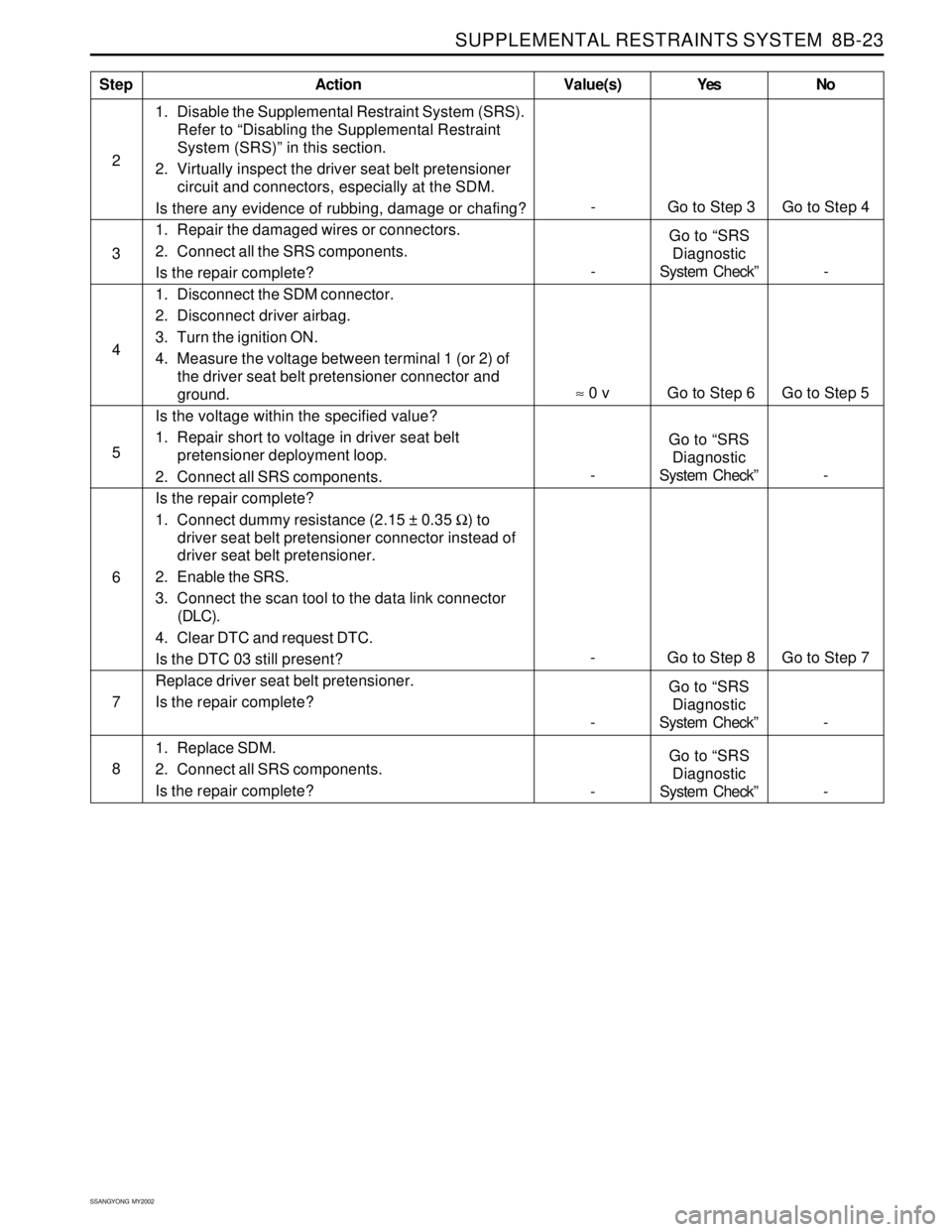
SUPPLEMENTAL RESTRAINTS SYSTEM 8B-23
SSANGYONG MY2002
1. Disable the Supplemental Restraint System (SRS).
Refer to “Disabling the Supplemental Restraint
System (SRS)” in this section.
2. Virtually inspect the driver seat belt pretensioner
circuit and connectors, especially at the SDM.
Is there any evidence of rubbing, damage or chafing?
1. Repair the damaged wires or connectors.
2. Connect all the SRS components.
Is the repair complete?
1. Disconnect the SDM connector.
2. Disconnect driver airbag.
3. Turn the ignition ON.
4. Measure the voltage between terminal 1 (or 2) of
the driver seat belt pretensioner connector and
ground.
Is the voltage within the specified value?
1. Repair short to voltage in driver seat belt
pretensioner deployment loop.
2. Connect all SRS components.
Is the repair complete?
1. Connect dummy resistance (2.15 ± 0.35 Ω) to
driver seat belt pretensioner connector instead of
driver seat belt pretensioner.
2. Enable the SRS.
3. Connect the scan tool to the data link connector
(DLC).
4. Clear DTC and request DTC.
Is the DTC 03 still present?
Replace driver seat belt pretensioner.
Is the repair complete?
1. Replace SDM.
2. Connect all SRS components.
Is the repair complete?
StepAction Value(s) Yes No
2
4
5
6
- Go to Step 3 Go to Step 4
3
-Go to “SRS
Diagnostic
System Check” -
≈ 0 v Go to Step 6 Go to Step 5
-Go to “SRS
Diagnostic
System Check” -
-Go to “SRS
Diagnostic
System Check” -
-Go to “SRS
Diagnostic
System Check” -
- Go to Step 8 Go to Step 7
7
8
Page 1611 of 2053
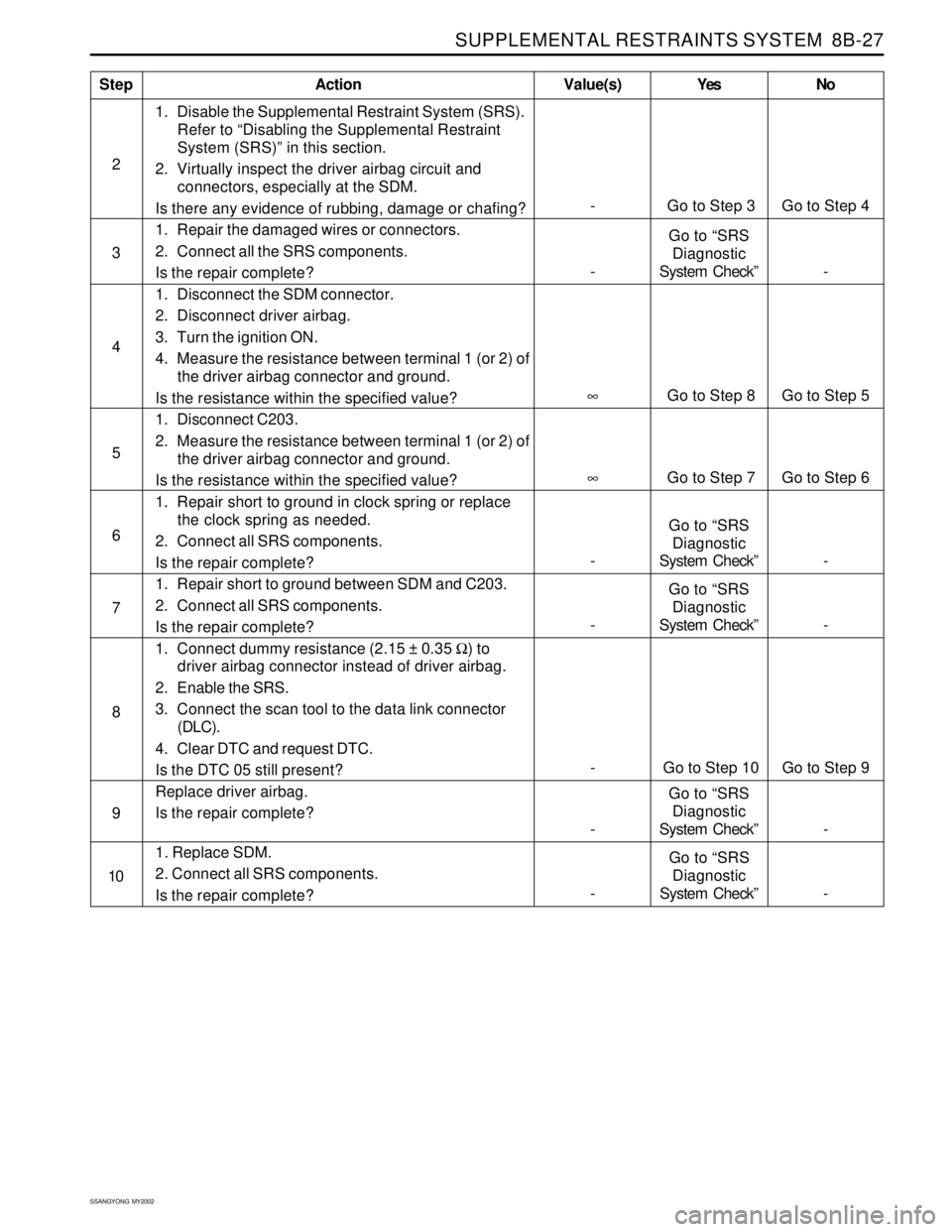
SUPPLEMENTAL RESTRAINTS SYSTEM 8B-27
SSANGYONG MY2002
1. Disable the Supplemental Restraint System (SRS).
Refer to “Disabling the Supplemental Restraint
System (SRS)” in this section.
2. Virtually inspect the driver airbag circuit and
connectors, especially at the SDM.
Is there any evidence of rubbing, damage or chafing?
1. Repair the damaged wires or connectors.
2. Connect all the SRS components.
Is the repair complete?
1. Disconnect the SDM connector.
2. Disconnect driver airbag.
3. Turn the ignition ON.
4. Measure the resistance between terminal 1 (or 2) of
the driver airbag connector and ground.
Is the resistance within the specified value?
1. Disconnect C203.
2. Measure the resistance between terminal 1 (or 2) of
the driver airbag connector and ground.
Is the resistance within the specified value?
1. Repair short to ground in clock spring or replace
the clock spring as needed.
2. Connect all SRS components.
Is the repair complete?
1. Repair short to ground between SDM and C203.
2. Connect all SRS components.
Is the repair complete?
1. Connect dummy resistance (2.15 ± 0.35 Ω) to
driver airbag connector instead of driver airbag.
2. Enable the SRS.
3. Connect the scan tool to the data link connector
(DLC).
4. Clear DTC and request DTC.
Is the DTC 05 still present?
Replace driver airbag.
Is the repair complete?
1. Replace SDM.
2. Connect all SRS components.
Is the repair complete?
StepAction Value(s) Yes No
2
4
5
6
- Go to Step 3 Go to Step 4
3
-Go to “SRS
Diagnostic
System Check” -
∞ Go to Step 8 Go to Step 5
-Go to “SRS
Diagnostic
System Check” -
-Go to “SRS
Diagnostic
System Check” -
-Go to “SRS
Diagnostic
System Check” -
- Go to Step 10 Go to Step 9 7
8
9
10
∞ Go to Step 7 Go to Step 6
-Go to “SRS
Diagnostic
System Check” -